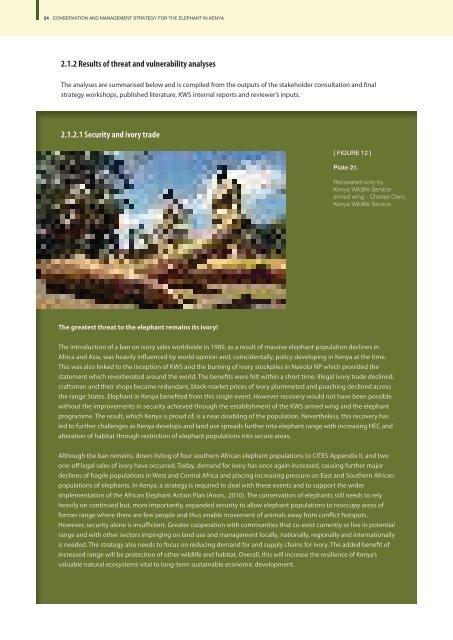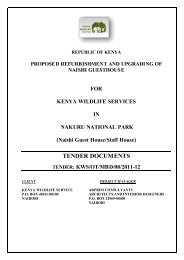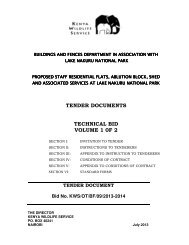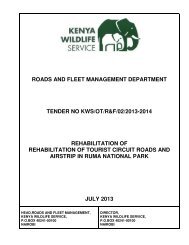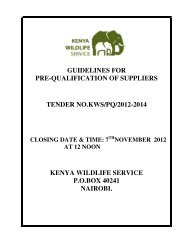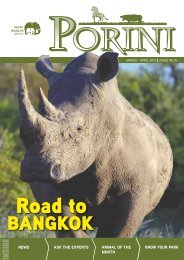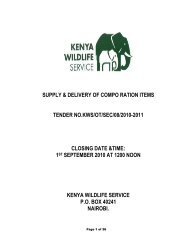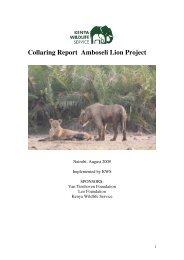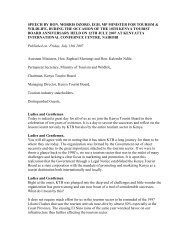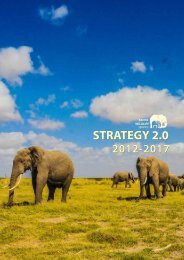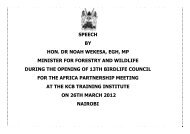Conservation and Management Strategy for the Elephant in Kenya
Conservation and Management Strategy for the Elephant in Kenya
Conservation and Management Strategy for the Elephant in Kenya
Create successful ePaper yourself
Turn your PDF publications into a flip-book with our unique Google optimized e-Paper software.
24 CONSERVATION AND MANAGEMENT STRATEGY FOR THE ELEPHANT IN KENYA<br />
2.1.2 Results of threat <strong>and</strong> vulnerability analyses<br />
The analyses are summarised below <strong>and</strong> is compiled from <strong>the</strong> outputs of <strong>the</strong> stakeholder consultation <strong>and</strong> f<strong>in</strong>al<br />
strategy workshops, published literature, KWS <strong>in</strong>ternal reports <strong>and</strong> reviewer’s <strong>in</strong>puts.<br />
2.1.2.1 Security <strong>and</strong> ivory trade<br />
[ FIGURE 12 ]<br />
Plate 21.<br />
Recovered ivory by<br />
<strong>Kenya</strong> Wildlife Service<br />
armed w<strong>in</strong>g - Charles Ooro,<br />
<strong>Kenya</strong> Wildlife Service<br />
The greatest threat to <strong>the</strong> elephant rema<strong>in</strong>s its ivory!<br />
The <strong>in</strong>troduction of a ban on ivory sales worldwide <strong>in</strong> 1989, as a result of massive elephant population decl<strong>in</strong>es <strong>in</strong><br />
Africa <strong>and</strong> Asia, was heavily <strong>in</strong>fluenced by world op<strong>in</strong>ion <strong>and</strong>, co<strong>in</strong>cidentally, policy develop<strong>in</strong>g <strong>in</strong> <strong>Kenya</strong> at <strong>the</strong> time.<br />
This was also l<strong>in</strong>ked to <strong>the</strong> <strong>in</strong>ception of KWS <strong>and</strong> <strong>the</strong> burn<strong>in</strong>g of ivory stockpiles <strong>in</strong> Nairobi NP which provided <strong>the</strong><br />
statement which reverberated around <strong>the</strong> world. The benefits were felt with<strong>in</strong> a short time: illegal ivory trade decl<strong>in</strong>ed,<br />
craftsman <strong>and</strong> <strong>the</strong>ir shops became redundant, black-market prices of ivory plummeted <strong>and</strong> poach<strong>in</strong>g decl<strong>in</strong>ed across<br />
<strong>the</strong> range States. <strong>Elephant</strong> <strong>in</strong> <strong>Kenya</strong> benefited from this s<strong>in</strong>gle event. However recovery would not have been possible<br />
without <strong>the</strong> improvements <strong>in</strong> security achieved through <strong>the</strong> establishment of <strong>the</strong> KWS armed w<strong>in</strong>g <strong>and</strong> <strong>the</strong> elephant<br />
programme. The result, which <strong>Kenya</strong> is proud of, is a near doubl<strong>in</strong>g of <strong>the</strong> population. Never<strong>the</strong>less, this recovery has<br />
led to fur<strong>the</strong>r challenges as <strong>Kenya</strong> develops <strong>and</strong> l<strong>and</strong> use spreads fur<strong>the</strong>r <strong>in</strong>to elephant range with <strong>in</strong>creas<strong>in</strong>g HEC <strong>and</strong><br />
alteration of habitat through restriction of elephant populations <strong>in</strong>to secure areas.<br />
Although <strong>the</strong> ban rema<strong>in</strong>s, down-list<strong>in</strong>g of four sou<strong>the</strong>rn African elephant populations to CITES Appendix II, <strong>and</strong> two<br />
one-off legal sales of ivory have occurred. Today, dem<strong>and</strong> <strong>for</strong> ivory has once aga<strong>in</strong> <strong>in</strong>creased, caus<strong>in</strong>g fur<strong>the</strong>r major<br />
decl<strong>in</strong>es of fragile populations <strong>in</strong> West <strong>and</strong> Central Africa <strong>and</strong> plac<strong>in</strong>g <strong>in</strong>creas<strong>in</strong>g pressure on East <strong>and</strong> Sou<strong>the</strong>rn African<br />
populations of elephants. In <strong>Kenya</strong>, a strategy is required to deal with <strong>the</strong>se events <strong>and</strong> to support <strong>the</strong> wider<br />
implementation of <strong>the</strong> African <strong>Elephant</strong> Action Plan (Anon., 2010). The conservation of elephants still needs to rely<br />
heavily on cont<strong>in</strong>ued but, more importantly, exp<strong>and</strong>ed security to allow elephant populations to reoccupy areas of<br />
<strong>for</strong>mer range where <strong>the</strong>re are few people <strong>and</strong> thus enable movement of animals away from conflict hotspots.<br />
However, security alone is <strong>in</strong>sufficient. Greater cooperation with communities that co-exist currently or live <strong>in</strong> potential<br />
range <strong>and</strong> with o<strong>the</strong>r sectors imp<strong>in</strong>g<strong>in</strong>g on l<strong>and</strong> use <strong>and</strong> management locally, nationally, regionally <strong>and</strong> <strong>in</strong>ternationally<br />
is needed. The strategy also needs to focus on reduc<strong>in</strong>g dem<strong>and</strong> <strong>for</strong> <strong>and</strong> supply cha<strong>in</strong>s <strong>for</strong> ivory. The added benefit of<br />
<strong>in</strong>creased range will be protection of o<strong>the</strong>r wildlife <strong>and</strong> habitat. Overall, this will <strong>in</strong>crease <strong>the</strong> resilience of <strong>Kenya</strong>’s<br />
valuable natural ecosystems vital to long-term susta<strong>in</strong>able economic development.


